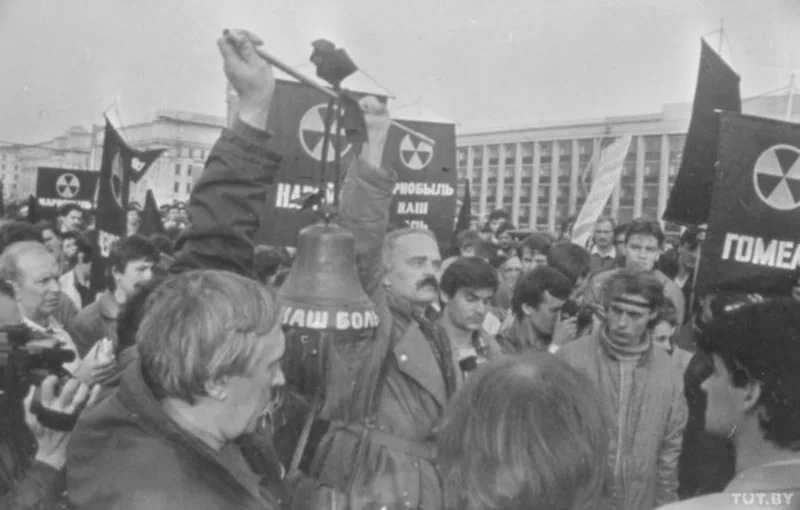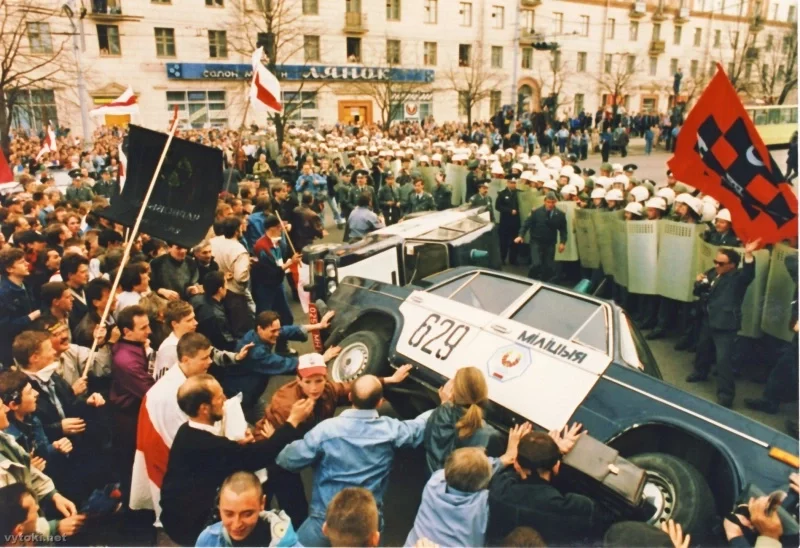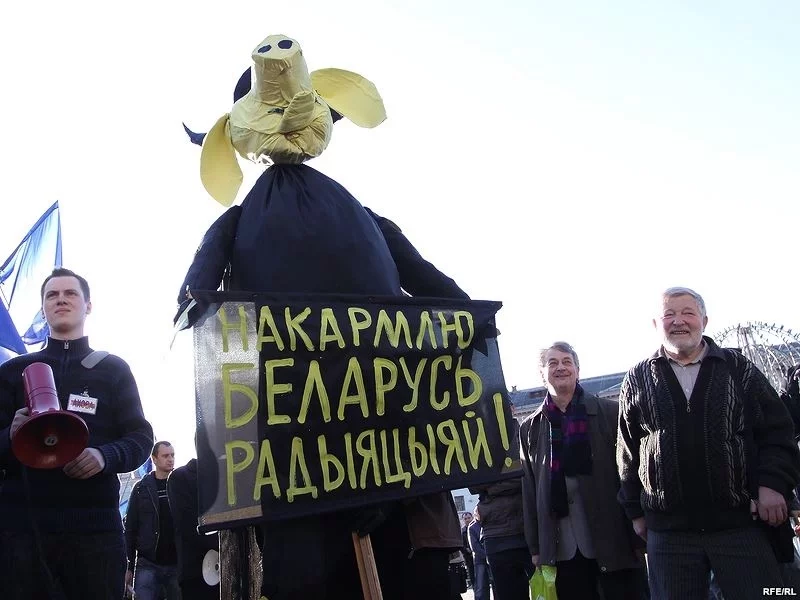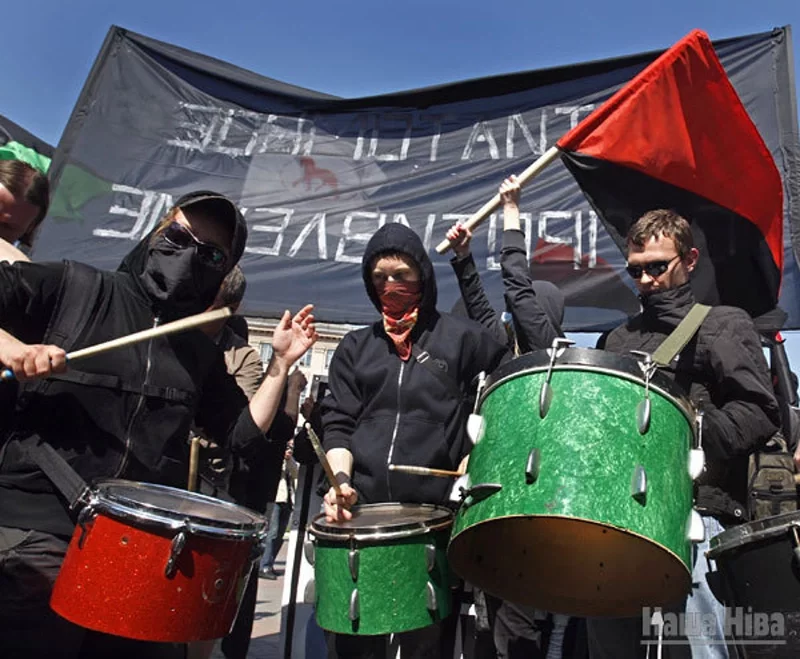April 26 is the day on which the Chernobyl Way (CHW) is traditionally held, and from April 19 to 26 is Chernobyl Week. This march commemorates the Chernobyl disaster and also symbolises the struggle against nuclear power and the nuclear path. After 2020, thousands of Belarusians were forced to emigrate and the CHW was moved to other countries such as Lithuania, Poland, Germany and the United States.
In this article we will tell about the history of the Chernobyl Way, consider the dangers of nuclear power, and talk about renewable energy sources with the co-founder of eco-house- Irina Sukhy.
The material was made with the support of the eco-house and based on a conversation with the co-founder of the eco-house, Irina Sukhy.


The Chernobyl Way in 1989. Photo from the archive of Andrei Skuratovich
History of the Chernobyl Way.
The first Chernobyl Way took place in 1989. Its organisers were politicians Zenon Pozniak, Gennadiy Grushevoy and Yury Khadyka. Then the slogans of the march were: ‘Chernobyl is our pain’ and ‘God save Belarus’. The rally was attended by about 25,000-30,000 people. Not without detentions: Khadyka was sentenced to 2 months of forced labour, and Grushevoy was fined.
In 1990-1995 the Chernobyl Way was not held.
In 1996 the action was organised by Vyacheslav Sivchik, Yury Khadyka and Vasil Bykov. The slogans ‘Long live Belarus!’, ‘Down with Lukash!’ and ‘Independence!’ were sounded. About 50,000 people took part in the action: there were clashes with the police, mass detentions, more than 100 people were injured.
In 1997, about 25,000 people took part in the action.
In 1998 Vyacheslav Sivchik again became the organiser of the march. People chanted: ‘Long Live Belarus! Lukashenka goes Kaput’, ‘Chernobyl is our common pain’. About 15,000 people took part in the action.
In 1999 the slogans changed a bit: ‘Hands off our home-Belarus!’, ‘No nuclear death!’, ‘We want to live!’ sounded at the action, which was attended by about 5000 people. 10 activists of the “Young Front” were detained.
From 2000 to 2018, the organisers of the Chernobyl Way were various individuals, including Ivan Nikitchenko, Vintsuk Viachorka, Vyacheslav Sivchik, the BPF Party, the United Civic Party, Charter 97, Liudmila Gryaznova, and the Green Party. Participation in the march varied from 30,000 people in 2000 to 300-400 people in 2015. The slogans at the rallies became more ecological in nature: ‘give medicine to Chernobyl invalids’, ‘memory for the future’, ‘stop the production of radioactive waste’, ‘we are against the nuclear reactor’, ‘Astravec NPP? Thank you, no’. Detentions of protesters have decreased, in some years of the 2000s there were none at all, but in others, such as in 2005, the Chernobyl Way was accompanied by clashes with riot police, and more than 30 people were detained.
From 2018 to 2020, marches took place every year. One of the members of our collective ‘Not Today, Not Yesterday, Not Tomorrow’ was a regular participant:
‘The marches after 2018 were not crowded, but colourful, they were decorated with a variety of banners and slogans, one of the slogans was ‘Atom is not peaceful, even animals know that!’. Anarchists began to take part in the demonstrations and made their contribution, in some years there was an anarchist column of drummers and costumed performances at the marches. There were almost no provocations from the cops, but there were. There were no mass detentions. I would like to add that every year the number of people taking part in the CHW has been noticeably decreasing, this may be due to repression by the state, where people believe that they can change something, or it may be due to the apolitical nature of the population, which began to become so under the aegis of the personal cult of individuality’, – he says.


The Chernobyl Way in 1996. Photo from the archive of Georgy Likhtarovich
Some of the main problems are related to nuclear power and nuclear power plants.
Accidents at nuclear power plants are rare but have enormous consequences.
Besides the famous Chernobyl and Fukushima, there are other cases. Even accident-free nuclear power plants release radioactive substances. Although the doses are small, studies show that children living close to nuclear power plants have increased risks of leukaemia.
Chernobyl has always been the number one issue for Belarusian environmentalists. The damage from radionuclide, radiation contamination is clearly underestimated and research on this topic has not been conducted in Belarus for a long time, which cannot be said, for example, about Ukraine. Apart from the Chernobyl damage, there are other factors that harm the ecology, and there are quite a lot of them, starting from the routine emissions of BelNPP and ending with the destruction of forests, depletion of biodiversity, and chemical pollution. All these harms add up, producing a cumulative effect.
Uranium mining and enrichment pose a risk to humans.
During uranium mining, radioactive gases such as radon and radium accumulate in mines, which can cause cancer. When uranium is enriched, the amount of radioactive waste increases, increasing human exposure. People living near the mines are also at risk.
The cooling of reactors leads to the death of living things in the water.
A large volume of water from rivers or seas is used for this purpose. Once the heated water is returned to the environment, it harms plants and animals and leads to their death.
Nuclear energy will have to be paid for even after the power plants are shut down because of the need to manage waste and decommission nuclear power plants. The average age of nuclear reactors in the world is 27 years and many of them require shutdown in the coming years. However, the cost of dismantling these plants is comparable to building them.
The problem of waste disposal is serious because the elements in spent nuclear fuel remain active for millennia. To date, no definitive solution to this problem has been found anywhere in the world. Currently, above-ground storage facilities are being built to store waste from nuclear power plants, designed to last for 50 years, in the hope that during this time scientists will find ways to solve it.
The problem of nuclear power plant weaponization.
The term “weaponization” comes from the English word “weapon” and means the use as a weapon of peaceful objects not intended for military operations. During military conflicts, nuclear power poses the threat of nuclear contamination, as nuclear power plants can be easily weaponized and used as weapons or threat objects.
Russia’s invasion of Ukraine was a prime example. Ukrainian nuclear power plants have become a source of danger to civilians because of the unpredictability of the military situation. Flying cruise missiles threaten to collide with reactors and spent nuclear fuel storage facilities. The risk of nuclear contamination spreads to nearby areas and other countries through wind-borne radioactive particles.


The Chernobyl Way. Photo from the archive of Radio Liberty 2010 Photo from the archive of Julia Doroshkevich in 2009
“The fact is that the construction of the Astravets NPP was non-transparent, with violations. Both Belarusan legislation and international conventions were violated,” – Interview with Irina Sukhy
– What’s wrong with Astravets NPP?
– The fact is that the construction of Astravets NPP was non-transparent, with violations. Both Belarusan legislation and international conventions were violated, and public access to information was limited. It was possible to learn about the Belarusian NPP only through the state mass media, but we know how these mass media inform. Yes, they reported about inspections and violations, but they did not disclose details: who checked it? And what exactly were the violations?
In addition, we know that two reactor units were damaged, one of them during transportation by rail. According to official data, there was “permissible” minimal deformation, which, according to claims, will not affect the reactor’s operation. However, many experts believe that the reactor vessel is a key element of a nuclear plant exposed to radioactive particles, and any micro-crack could be a source of potential danger in the future.
There have been many other incidents during construction, such as the collapse of concrete structures, which raises valid concerns about the quality of the facility. The choice of site for the NPP also raises questions: the site in Astrovets was rejected in Soviet times because of the 6-7 magnitude earthquakes recorded there. However, this data was apparently not taken into account when the decision was made. Why was this particular site chosen? Probably because of the desire to sell electricity in the West.
Now there are problems with selling the power, as Lithuania refuses to buy it, and it is not clear where the excess power should be directed. Thus, the construction of the nuclear power plant has led to contradictions in plans to save energy consumption in the country.
– How much money from the budget was spent on NPPs and what is cheaper to build NPPs or renewable energy sources (RES)?
– It was not budget money, but funds from a Russian loan. Initially it was planned that the construction would cost 10 billion dollars, but according to Lukashenko’s statements, it was done within 7 billion dollars. But the question remains: what was the difference saved on? The average time of NPP construction is 10 years, which is much longer than the construction of solar or wind power plants. Wind farms, for example, can be erected in just a few months and put into operation quickly.
Of course, construction of RES is cheaper. Today, the cost of solar energy ranges from $36 to $44 per megawatt-hour (MWh), while onshore wind farms cost $29 to $56 per MWh. In comparison, nuclear energy costs between $112 and $189 per MWh for new nuclear power plants. However, it should be clarified that we are talking about production costs, not the final price for the consumer. In Belarus, the difference in price for the end user is not felt, but in countries with developed market economies it is clearly noticeable.
– Can renewables compete with nuclear power?
– In Europe, the plan of the EU countries is to switch to 100% renewable energy sources by 2050. And there is such a scenario of energy revolution, in 2018 it was calculated by a German agency, which made these scenarios for 40 countries. And some countries are repeating these scenarios and considering them. Because technologies change, prices are recalculated, and based on this, on such scenarios, countries develop energy strategies. And we also wanted Belarus to rely on these scenarios and to follow the path of sustainable energy rather than nuclear energy.
If we talk about competition, yes, they compete with each other. If we have nuclear power, it leaves little room for the development of renewable energy, which is what we see in Belarus now. Nuclear power is ‘stablel’, so to speak. Energy production is stable and it is difficult to tweak something there to produce more or less energy. It follows such a stable path, but energy is consumed unevenly, there are peaks, there are dips, when less energy is consumed. And this is usually regulated by gas stations, gas stations are good precisely because these gaps or vice versa when it is necessary to increase the flow of energy, these fluctuations are mixed. Accordingly, RES has its own limit of possibilities, the sun is there during the day, not at night, the wind depends on climatic conditions, and the energy is unstable, it needs to be adjusted. And these combinations of renewables with gas power mixes well. And when we have a monster nuclear power plant, which produces almost with a second reactor close to half 38% of all energy, it is clear that it is difficult to combine other energy sources with it.

Chernobyl Way 1996 Photo from the archive Sergey Brushko
In general, Belarus has a potential for RES and this scenario shows that it is enough. And there are calculations that show that transition to RES is more profitable for the country than gas or nuclear power.
– Why is RES still not a favourite in the energy development of the country?
– There are many factors influencing here. First, Lukashenko has expressed his intentions to build another nuclear power plant. However, it is necessary to create suitable conditions for the development of renewable energy sources. Many countries had mechanisms, such as increased tariffs for renewable energy, and this was a means of stimulating investment in these areas. Similar measures have been applied in our country, but due to the lack of market mechanisms in the energy sector, this has often resulted in the state having to purchase energy at increased tariffs. Private investors made their investments, but the population had no choice because of the lack of market relations. Everything was regulated by large subsidies, and only then this energy was sold to the population. ‘Belenergo’ covered the costs of this from its profits, but obviously it was not profitable for them, so they resisted: it was difficult to connect and get all the necessary permits. Then the introduction of the law, and then its amendments restricting the issuance of quotas for renewable energy production, became another obstacle to the development of this initiative. In order to bring about change, it is necessary to get rid of monopolies and introduce market relations. Things have to be different in the country for something to really change.
– Can you tell us about measures to combat the construction of nuclear power plants?
– Belarus has currently withdrawn from the Aarhus Convention. It is important to note that this convention stipulates mandatory public participation in the decision-making process, especially concerning the construction of facilities such as NPPs. When Belarus decided to build a nuclear power plant, it violated this requirement, which in turn led to protests from public organisations, including Ecodom. In other countries, such as Germany, the anti-nuclear movement has played a key role in shutting down all nuclear power plants. In these countries, there are mechanisms for expressing public opinion, such as demonstrations, pickets and protests, without risking imprisonment, as is the case in Belarus. For example, in 2009, Russian nuclear physicist Zharovsky was detained during a hearing on NPP construction and spent 7 days in jail. In 2012, when a group of activists tried to deliver a petition to the Russian Embassy, Zharovsky was again detained and spent 10 days in jail, after which he was deported from the country with a ban on entry for 10 years. We got away with 24 hours, and he got deported. This is how you can express your opinion in our country.
The full history of the Chernobyl Way can be read here.
Information about the Chernobyl Way in different cities and countries, about events related to Chernobyl Week can be found on the link on the Ecodom website and the Green Portal.


